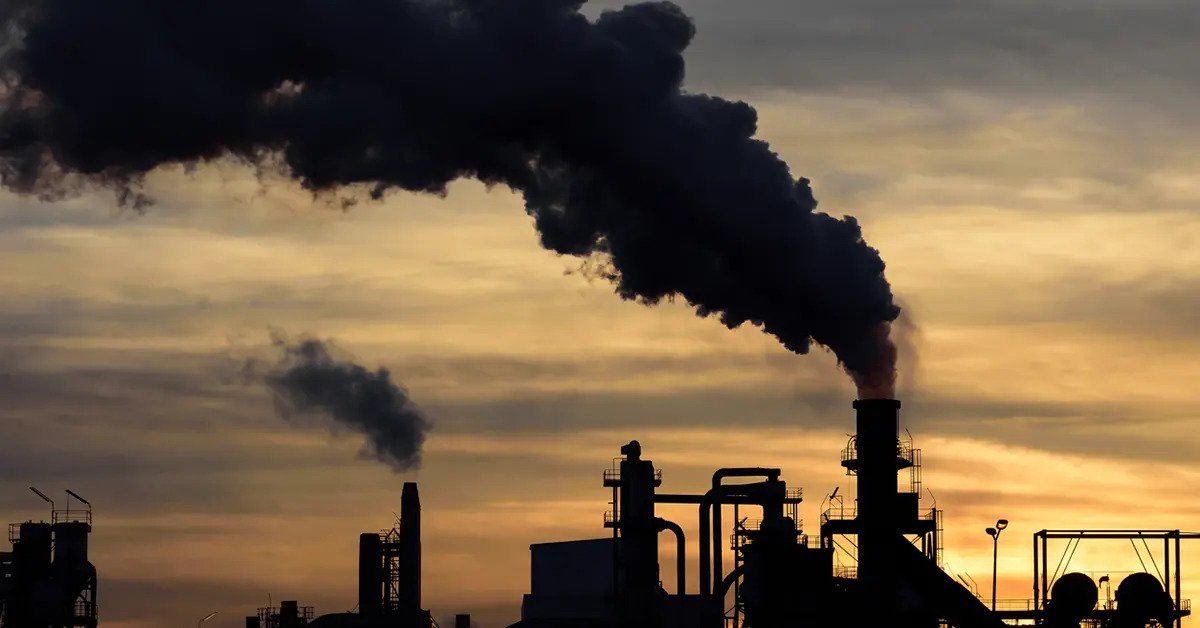Home>Gardening News and Trends>Explain Why Earth’s Atmosphere Is Like The Glass In A Greenhouse


Gardening News and Trends
Explain Why Earth’s Atmosphere Is Like The Glass In A Greenhouse
Modified: January 22, 2024
Discover the latest news on why Earth's atmosphere functions like the glass in a greenhouse, contributing to climate change and global warming.
(Many of the links in this article redirect to a specific reviewed product. Your purchase of these products through affiliate links helps to generate commission for Chicagolandgardening.com, at no extra cost. Learn more)
Table of Contents
- Introduction
- The Greenhouse Effect
- Earth’s Atmosphere: Composition and Structure
- Similarities between Earth’s Atmosphere and a Greenhouse
- Solar Radiation: The Energy Source
- Greenhouse Gases: Trapping Heat
- The Role of Water Vapor
- The Importance of Carbon Dioxide
- Other Greenhouse Gases
- Enhanced Greenhouse Effect: Human Impact
- Global Warming: Consequences and Concerns
- Conclusion
Introduction
The Earth’s atmosphere plays a crucial role in maintaining a habitable environment for life as we know it. It acts as a protective shield, regulating temperatures and allowing for the presence of water, which is essential for supporting life. One of the fascinating aspects of the Earth’s atmosphere is its resemblance to the glass structure of a greenhouse. This concept, known as the greenhouse effect, helps to explain how our atmosphere retains heat and keeps the planet warm. Understanding the greenhouse effect and its relationship to Earth’s atmosphere is essential in comprehending the pressing issue of global warming.
The greenhouse effect is a natural phenomenon that has been occurring on Earth for millions of years. Just like the glass walls of a greenhouse, which allow sunlight to enter but prevent the escape of heat, the Earth’s atmosphere traps and holds solar radiation. This trapped heat is crucial for maintaining the planet’s temperature at levels suitable for supporting life. Without the greenhouse effect, the Earth would be a much colder and inhospitable place.
To comprehend why the Earth’s atmosphere acts like the glass in a greenhouse, it is necessary to have an understanding of its composition and structure. The Earth’s atmosphere is composed of several layers, each with distinct characteristics and purposes. The most prominent layers are the troposphere, stratosphere, mesosphere, thermosphere, and exosphere. These layers differ in terms of temperature, pressure, and composition, with the troposphere being the closest to the Earth’s surface.
Within the Earth’s atmosphere, there are various gases that contribute to the greenhouse effect. These greenhouse gases, including carbon dioxide (CO2), methane (CH4), nitrous oxide (N2O), and water vapor (H2O), play a crucial role in regulating the amount of heat that is trapped within the atmosphere. While greenhouse gases make up only a small percentage of the overall composition of the atmosphere, their impact on the Earth’s temperature cannot be underestimated.
In this article, we will explore the greenhouse effect and delve deeper into the similarities between Earth’s atmosphere and a greenhouse. We will examine how solar radiation acts as the primary energy source and how greenhouse gases, particularly carbon dioxide, contribute to trapping heat. Additionally, we will discuss the consequences of an enhanced greenhouse effect caused by human activities and the alarming issue of global warming.
The Greenhouse Effect
The greenhouse effect is a natural process that occurs in the Earth’s atmosphere, allowing the planet to maintain a relatively stable temperature. It is crucial for supporting life as we know it. The term “greenhouse effect” was coined because of the similarity between the Earth’s atmosphere and the protective structure of a greenhouse, which both retain heat.
The greenhouse effect starts with the Sun’s energy reaching the Earth in the form of solar radiation. The Earth’s surface absorbs some of this energy and re-emits it as infrared radiation. Greenhouse gases in the atmosphere, such as carbon dioxide (CO2), methane (CH4), and water vapor (H2O), intercept and absorb this infrared radiation. Unlike visible light, which can easily pass through the greenhouse gases, the absorbed radiation cannot escape freely back into space.
This trapped heat is then radiated in all directions, including back towards the Earth’s surface. This process creates a natural balance by keeping the planet warm. Without the greenhouse effect, the Earth’s average temperature would be significantly lower, making it inhospitable for most forms of life.
While the greenhouse effect is a natural and necessary phenomenon, human activities have increased the concentrations of greenhouse gases in the atmosphere. The burning of fossil fuels, deforestation, and industrial processes have led to a significant rise in carbon dioxide levels in the atmosphere, contributing to what is known as the enhanced greenhouse effect.
The enhanced greenhouse effect, caused by human-induced emissions of greenhouse gases, is leading to an imbalance in the Earth’s energy budget. The excess accumulation of greenhouse gases is intensifying the greenhouse effect and causing the Earth to retain more heat than needed. This phenomenon, commonly referred to as global warming, has profound implications for the planet and all living organisms.
Scientists and researchers around the world are closely studying the greenhouse effect and its consequences. Understanding the dynamics of this process is crucial for developing strategies to mitigate the effects of global warming and strive towards a more sustainable future.
Earth’s Atmosphere: Composition and Structure
The Earth’s atmosphere is a complex and dynamic system that surrounds our planet, providing a protective barrier between us and the vastness of outer space. It is composed of a mixture of gases, each with distinct properties and functions. Understanding the composition and structure of Earth’s atmosphere is vital in comprehending how it interacts with the greenhouse effect and regulates our climate.
The atmosphere is primarily made up of nitrogen (about 78%) and oxygen (about 21%), with traces of other gases such as argon, carbon dioxide, and neon making up the remaining fraction. These gases are distributed across several layers that vary in composition, temperature, and pressure. The layers include the troposphere, stratosphere, mesosphere, thermosphere, and exosphere.
The troposphere is the layer closest to the Earth’s surface and extends about 7 to 20 kilometers above the surface at the poles and up to 17 kilometers at the equator. This layer contains the majority of the Earth’s weather systems, including clouds and precipitation. As we move upwards through the troposphere, the temperature decreases at an average rate of 6.5 degrees Celsius per kilometer.
Above the troposphere lies the stratosphere, which extends from the top of the troposphere to about 50 kilometers above the Earth’s surface. The stratosphere contains the ozone layer, an essential component for absorbing harmful ultraviolet (UV) radiation from the Sun. Ozone molecules in the stratosphere absorb UV radiation, converting it into heat energy and shielding the Earth’s surface from excessive UV exposure.
Beyond the stratosphere is the mesosphere, extending approximately 50 to 85 kilometers above the Earth’s surface. In this layer, temperatures steadily decrease with increasing altitude, reaching their lowest point known as the mesopause. The mesosphere is also the layer where meteors burn up upon entering the Earth’s atmosphere, creating beautiful streaks of light in the sky known as shooting stars.
Next, we have the thermosphere, which stretches from the mesopause to approximately 600 kilometers above the Earth’s surface. Despite its high altitude, the thermosphere experiences extremely high temperatures due to its exposure to intense solar radiation. However, as the atmosphere in this layer is thin, the heat is not felt by objects within it.
The outermost layer of the Earth’s atmosphere is the exosphere. This region extends from the thermosphere to the edge of space, merging seamlessly with the vacuum of outer space. The gases in this layer are extremely sparse, and collisions between particles are rare.
Understanding the composition and structure of Earth’s atmosphere provides a foundation for comprehending its role in regulating temperature and supporting life. The different layers and their unique characteristics contribute to the dynamics of the greenhouse effect and the planet’s overall climate system.
Similarities between Earth’s Atmosphere and a Greenhouse
There are striking similarities between Earth’s atmosphere and the glass structure of a greenhouse. These similarities help to explain why the Earth’s atmosphere acts like a greenhouse, retaining heat and maintaining a relatively stable temperature. Understanding these parallels is essential in comprehending the greenhouse effect and its impact on our planet.
Just like the glass walls of a greenhouse, Earth’s atmosphere allows sunlight to enter freely. Sunlight is composed of various wavelengths, including visible light and ultraviolet (UV) radiation. When sunlight reaches the Earth’s surface, it warms the land, oceans, and vegetation.
Similarly, a greenhouse’s glass panels allow sunlight to pass through, providing energy for plants and objects inside the structure. This incoming solar radiation is essential for photosynthesis, plant growth, and maintaining a warm environment within the greenhouse.
However, the similarities between Earth’s atmosphere and a greenhouse become more apparent when considering heat transfer. Once the energy from the Sun reaches the Earth’s surface, it gets re-emitted as longer-wavelength infrared radiation. This infrared radiation has difficulty escaping back into space due to the presence of greenhouse gases in the atmosphere.
In a greenhouse, the glass panels transmit visible light, but they are much less effective at allowing the escape of heat. The trapped heat causes the interior of the greenhouse to warm up significantly, creating a suitable environment for plant growth and cultivation.
Similarly, in the Earth’s atmosphere, greenhouse gases such as carbon dioxide, methane, and water vapor act as a barrier to the escape of infrared radiation. These greenhouse gases absorb and re-emit the infrared radiation, trapping it within the atmosphere and preventing it from dissipating into space.
This trapping of heat is crucial for maintaining a stable and habitable environment on Earth. Without the greenhouse effect, the Earth’s average temperature would be around -18 degrees Celsius, rendering it uninhabitable for most forms of life.
It is important to note that while the greenhouse effect in a greenhouse is deliberate and controlled, the greenhouse effect in the Earth’s atmosphere occurs naturally and has been in existence for millions of years. The concentration of greenhouse gases in the atmosphere has been regulated by natural processes.
However, human activities, primarily the burning of fossil fuels and deforestation, have led to an increase in greenhouse gas concentrations, intensifying the greenhouse effect. This enhanced greenhouse effect, commonly referred to as global warming, is causing concerns about the stability of Earth’s climate and the potential for catastrophic consequences.
By understanding the parallels between Earth’s atmosphere and a greenhouse, we can appreciate the significance of the greenhouse effect and the importance of reducing greenhouse gas emissions to mitigate the effects of global warming.
Solar Radiation: The Energy Source
Solar radiation is the primary source of energy for the Earth’s climate system and plays a crucial role in driving the greenhouse effect. The Sun emits vast amounts of energy in the form of electromagnetic radiation, including visible light, ultraviolet (UV) radiation, and infrared (IR) radiation. This solar radiation provides the energy needed for life on Earth.
When sunlight reaches the Earth’s atmosphere, it undergoes various interactions. A portion of the solar radiation is absorbed by the atmosphere, clouds, and the Earth’s surface. This absorbed energy is then transformed and redistributed throughout the Earth’s climate system.
The energy absorbed by the Earth’s surface is a result of the interaction between sunlight and the Earth’s land, oceans, and vegetation. Different surfaces absorb solar radiation to varying degrees. Darker surfaces, such as forests and oceans, absorb more solar energy, while lighter surfaces, like ice and snow, reflect more of the incoming radiation.
Once the solar energy is absorbed by the Earth’s surface, it is converted into heat energy, leading to an increase in temperature. This thermal energy is then transferred into the surrounding atmosphere through conduction, convection, and radiation processes.
Furthermore, the absorbed solar radiation is an essential driver for the Earth’s weather and climate systems. It powers the evaporation of water, which subsequently leads to cloud formation and precipitation. Solar energy also fuels winds, ocean currents, and the hydrological cycle, contributing to the overall circulation of the Earth’s atmosphere and oceans.
Solar radiation is also responsible for providing the energy that sustains life on Earth. Through the process of photosynthesis, plants convert sunlight into chemical energy, storing it in the form of glucose. This energy is then transferred through the food chain, supporting all living organisms.
Within the context of the greenhouse effect, solar radiation plays a critical role in the overall balance of Earth’s energy budget. The incoming solar radiation is the primary energy source that heats the Earth’s surface. Without this energy input, the Earth’s average temperature would be drastically lower.
Understanding the role of solar radiation as the energy source for the Earth’s climate system is essential in comprehending the dynamics of the greenhouse effect. It is through the absorption and re-emission of this solar energy that the greenhouse effect comes into play, regulating the planet’s temperature and making it conducive for life as we know it.
Greenhouse Gases: Trapping Heat
Greenhouse gases play a vital role in the Earth’s climate system by trapping heat and contributing to the greenhouse effect. These gases, which include carbon dioxide (CO2), methane (CH4), nitrous oxide (N2O), and water vapor (H2O), act as a natural insulation layer in the atmosphere, allowing sunlight to pass through but preventing the escape of heat energy.
When solar radiation enters the Earth’s atmosphere, some of it is absorbed by the Earth’s surface. As the surface heats up, it radiates heat energy back into the atmosphere in the form of infrared radiation. This emitted heat would typically escape into space, but greenhouse gases present in the atmosphere absorb some of the infrared radiation.
Greenhouse gases have unique molecular structures that enable them to absorb infrared radiation. When these gases absorb the radiation, it causes the molecules to vibrate and increase in kinetic energy. As a result, the energy is transformed into thermal energy, ultimately causing the surrounding air to warm up.
The trapped heat energy is then radiated back towards the Earth’s surface and throughout the lower atmosphere, contributing to an overall increase in temperature. This process is instrumental in maintaining the Earth’s average surface temperature above the freezing point and creating a habitable environment for life to thrive.
Water vapor is the most abundant greenhouse gas in the Earth’s atmosphere, and its concentration varies significantly depending on geographical location and weather conditions. Water vapor acts as a strong absorber and emitter of infrared radiation, intensifying the greenhouse effect. However, it also plays a crucial role in atmospheric cooling through the process of condensation and precipitation, effectively regulating its concentration.
Carbon dioxide, although present in smaller quantities compared to water vapor, is a significant contributor to the greenhouse effect. It is primarily released into the atmosphere through human activities such as the burning of fossil fuels, deforestation, and industrial processes. The increased concentration of carbon dioxide in the atmosphere has resulted in an enhanced greenhouse effect, leading to global warming and climate change.
Methane is another potent greenhouse gas, although it exists in much lower concentrations compared to carbon dioxide. Methane is mainly produced by natural processes such as microbial decomposition of organic matter in wetlands, as well as through human activities such as agriculture, livestock, and the extraction and transport of fossil fuels.
Nitrous oxide, released from both natural and anthropogenic sources, is a less abundant but potent greenhouse gas. It is primarily produced through agricultural and industrial activities, as well as from the combustion of fossil fuels. Nitrous oxide has a much longer atmospheric lifetime compared to carbon dioxide and methane, contributing to its long-term warming effect.
The presence of these greenhouse gases in the Earth’s atmosphere allows for the regulation of heat energy, maintaining a relatively stable and habitable climate on our planet. However, human activities have significantly disrupted this balance, leading to an increase in greenhouse gas concentrations and an intensification of the greenhouse effect. The consequences of this enhanced greenhouse effect, such as global warming and climate change, pose significant challenges for the future of our planet.
The Role of Water Vapor
Water vapor is a crucial component of Earth’s atmosphere and plays a significant role in the Earth’s climate system and the greenhouse effect. As the most abundant greenhouse gas, water vapor acts as both a contributor to and regulator of the overall temperature and moisture content of the atmosphere.
Water vapor is constantly present in the lower atmosphere in varying concentrations due to evaporation from oceans, lakes, rivers, and other bodies of water. When sunlight reaches the Earth’s surface, it heats the water, causing it to evaporate and rise into the atmosphere as water vapor. This process of evaporation transfers heat energy from the surface to the atmosphere.
As water vapor rises and cools, it condenses into tiny droplets or ice crystals, forming clouds and, eventually, precipitation. This condensation process releases the heat energy absorbed from the surface back into the atmosphere, which helps to regulate temperature and cool the surrounding air.
Water vapor’s ability to absorb and emit infrared radiation makes it an important greenhouse gas. As sunlight reaches the Earth’s surface, some of it is absorbed and re-emitted as thermal or infrared radiation. Water vapor in the atmosphere readily absorbs this infrared radiation, trapping and storing the heat energy.
Due to its abundance and strong absorptive properties, water vapor accounts for the majority of the natural greenhouse effect. It effectively prevents the escape of heat energy from the Earth’s surface, helping to maintain a relatively stable, habitable climate.
Water vapor’s role in the greenhouse effect extends beyond its ability to trap heat. When water vapor condenses and forms clouds, it also reflects incoming sunlight, known as the albedo effect. This reflection helps to cool the Earth’s surface by reducing the amount of solar radiation that reaches the surface, thereby balancing the overall energy budget.
Additionally, water vapor acts as a source of latent heat. When water vapor condenses into liquid water during cloud formation or precipitation, it releases latent heat into the atmosphere. This latent heat energy is then distributed through the atmosphere, influencing weather patterns and contributing to the formation of storms and cyclones.
While water vapor plays a critical role in the Earth’s climate system, its concentration in the atmosphere is highly variable, influenced by temperature, humidity, and weather patterns. The ability of the atmosphere to hold water vapor is temperature-dependent, with warmer air capable of holding more water vapor than colder air. This variability in water vapor concentration contributes to the dynamic nature of Earth’s weather systems.
Overall, water vapor’s presence in the atmosphere as a greenhouse gas is essential for maintaining Earth’s overall temperature balance. It acts as both a regulator of temperature and a contributor to the greenhouse effect, playing a vital role in shaping our planet’s climate and weather patterns.
The Importance of Carbon Dioxide
Carbon dioxide (CO2) is a key greenhouse gas that plays a significant role in the Earth’s climate system and the continuation of life on our planet. While it exists in relatively small quantities compared to other gases in the atmosphere, the impact of carbon dioxide on the greenhouse effect is substantial, making it an essential focus of scientific research and environmental concern.
Carbon dioxide is released into the atmosphere through both natural processes and human activities. Natural sources include volcanic eruptions, decay of organic matter, and respiration by plants and animals. However, human activities such as the burning of fossil fuels, deforestation, and industrial processes have dramatically increased carbon dioxide concentrations in recent decades.
One of the primary roles of carbon dioxide in the greenhouse effect is its ability to absorb and re-emit infrared radiation. As thermal energy is emitted from the Earth’s surface, carbon dioxide molecules in the atmosphere capture a portion of this radiation, preventing it from escaping freely into space. This trapped heat contributes to the warming of the Earth’s surface and lower atmosphere, creating the greenhouse effect.
In addition to its direct impact on the greenhouse effect, carbon dioxide also influences Earth’s climate system in other ways. It is an essential component of the carbon cycle, a natural process that involves the exchange of carbon between the Earth’s oceans, land, atmosphere, and living organisms.
Through photosynthesis, plants absorb carbon dioxide from the atmosphere and convert it into organic compounds, releasing oxygen as a byproduct. This process helps to regulate carbon dioxide levels and balance the overall atmospheric composition. When plants and animals respire or decompose, they release carbon dioxide back into the atmosphere, continuing the cyclical nature of the carbon cycle.
Furthermore, carbon dioxide dissolved in the Earth’s oceans plays a critical role in the regulation of ocean acidity. When carbon dioxide dissolves in seawater, it reacts with water to form carbonic acid, leading to a decrease in ocean pH. This process is called ocean acidification and can have detrimental impacts on marine organisms such as coral reefs and shell-forming organisms.
It is important to recognize that while carbon dioxide is an essential component of the Earth’s climate system and supports life on our planet, the increasing concentration of carbon dioxide due to human activities has profound consequences. The burning of fossil fuels, deforestation, and land-use changes have led to a significant rise in carbon dioxide levels, contributing to the enhanced greenhouse effect and global warming.
Addressing the importance of carbon dioxide requires a comprehensive approach, including the reduction of greenhouse gas emissions, the transition to renewable energy sources, and sustainable land management practices. Understanding the role of carbon dioxide in the Earth’s climate system is vital in developing strategies to mitigate climate change and ensure a sustainable future for our planet.
Other Greenhouse Gases
In addition to carbon dioxide, there are other greenhouse gases that contribute to the greenhouse effect and impact the Earth’s climate system. While their concentrations in the atmosphere are considerably lower compared to carbon dioxide, these gases play significant roles in regulating the Earth’s temperature and influencing climate patterns.
Methane (CH4) is an important greenhouse gas with a warming potential significantly higher than that of carbon dioxide. It is released through both natural processes and human activities. Natural sources include wetlands, termites, and the digestive systems of ruminant animals. On the other hand, human activities such as agriculture, livestock farming, landfills, and the extraction and transport of fossil fuels are sources of anthropogenic methane emissions.
Nitrous oxide (N2O) is another potent greenhouse gas with a significantly higher warming potential than carbon dioxide. It is emitted from natural processes such as microbial action in soils and the oceans, as well as from human activities like agricultural practices and industrial processes. Nitrous oxide also contributes to ozone depletion and catalyzes the destruction of stratospheric ozone.
Chlorofluorocarbons (CFCs) and hydrochlorofluorocarbons (HCFCs) are synthetic greenhouse gases that were historically used in a variety of applications including refrigeration, air conditioning, and aerosol propellants. These gases, along with other halocarbons, have high global warming potentials and also play a significant role in the depletion of the ozone layer.
Additionally, there are other minor greenhouse gases, including ozone (O3), which has both warming and cooling effects depending on its location in the atmosphere. In the lower atmosphere, ozone acts as a greenhouse gas, trapping heat. However, in the upper atmosphere, ozone helps protect the Earth’s surface from harmful UV radiation.
Water vapor (H2O), although its concentration varies greatly depending on location and weather conditions, is also considered a greenhouse gas. While it is not directly regulated by human activities, changes in temperature and atmospheric moisture content can influence water vapor concentrations, further amplifying the greenhouse effect.
Understanding the role of these other greenhouse gases is essential in comprehending the complexity of the Earth’s climate system and the factors that contribute to global warming. While carbon dioxide is often the primary focus due to its abundance and long atmospheric lifetime, these other gases can also have significant impacts on greenhouse gas radiative forcing and climate change.
Efforts to mitigate climate change and reduce the greenhouse effect must consider not only carbon dioxide emissions but also the emissions of these other greenhouse gases. International agreements and regulations have aimed to limit the production of synthetic gases and reduce emissions from agriculture and industrial processes to minimize their impact on the atmosphere and secure a more sustainable future for our planet.
Enhanced Greenhouse Effect: Human Impact
The enhanced greenhouse effect refers to the intensification of the natural greenhouse effect caused by human activities, particularly the burning of fossil fuels, deforestation, and industrial processes. This human-induced increase in greenhouse gas emissions has led to an imbalance in Earth’s climate system and has significant implications for the planet’s temperature, weather patterns, and ecosystems.
Human activities, especially the burning of fossil fuels such as coal, oil, and gas, release large amounts of carbon dioxide (CO2) into the atmosphere. Carbon dioxide has a long atmospheric lifetime, meaning that once it is emitted, it can persist in the atmosphere for decades to centuries. As a result, the concentration of CO2 in the atmosphere has increased by more than 45% since the Industrial Revolution.
This rise in carbon dioxide, along with increased emissions of other greenhouse gases like methane and nitrous oxide, has led to an enhanced greenhouse effect. The additional greenhouse gases in the atmosphere trap more of the outgoing infrared radiation, preventing it from escaping into space. This results in a gradual warming of the Earth’s surface and lower atmosphere, leading to global warming.
The consequences of the enhanced greenhouse effect are far-reaching. Rising global temperatures have caused shifts in climate patterns, including more frequent and severe heatwaves, prolonged droughts, and intense rainfall events. These changes in weather patterns have been linked to increased risks of extreme weather events such as hurricanes, typhoons, and wildfires.
Furthermore, the warming temperatures have accelerated the melting of glaciers and ice caps, leading to a rise in sea levels. This poses a threat to coastal communities, ecosystems, and infrastructure, increasing the risks of coastal erosion, flooding, and salinization of freshwater sources.
The enhanced greenhouse effect also disrupts ecosystems and biodiversity. Many species struggle to adapt to the rapidly changing climate, leading to shifts in the distribution and abundance of plant and animal populations. This can have cascading effects on entire ecosystems, impacting food webs and ecological interactions.
It is important to note that the impact of the enhanced greenhouse effect is not evenly distributed across the globe. Developing countries and vulnerable populations are typically most affected by the consequences of climate change, despite contributing less to greenhouse gas emissions. These communities often face challenges in adapting to the changing climate and coping with the associated risks.
Addressing the human impact on the enhanced greenhouse effect requires collective efforts to reduce greenhouse gas emissions and transition to renewable and sustainable energy sources. This includes adopting energy-efficient practices, promoting renewable energy technologies, and implementing sustainable land management practices to mitigate deforestation and promote reforestation.
International agreements such as the Paris Agreement aim to limit global warming to well below 2 degrees Celsius above pre-industrial levels and to pursue efforts to limit the temperature increase to 1.5 degrees Celsius. Meeting these goals requires the commitment and collaboration of governments, industries, communities, and individuals worldwide to reduce emissions and work towards a more sustainable and resilient future.
Global Warming: Consequences and Concerns
Global warming, as a result of the enhanced greenhouse effect, has significant consequences for the Earth’s climate system and poses a range of concerns for the planet and its inhabitants. This ongoing trend of rising average temperatures has far-reaching impacts on ecosystems, weather patterns, human societies, and the overall health of the planet.
One of the most evident consequences of global warming is the melting of ice caps and glaciers. As temperatures rise, these frozen reserves of freshwater are rapidly melting, contributing to a rise in sea levels. This threatens coastal communities, low-lying islands, and vulnerable ecosystems, increasing the risks of flooding, erosion, and the loss of important coastal habitats.
Changes in climate patterns also lead to an increase in extreme weather events. Heatwaves become more frequent and intense, posing health risks, particularly for vulnerable populations. Droughts become longer and more severe, affecting agriculture, water supplies, and food security. Intense rainfall events result in more frequent flooding and an increased likelihood of landslides.
Global warming also disrupts ecosystems and biodiversity. Many species struggle to adapt to the rapidly changing climate, leading to habitat loss, shifts in species distributions, and the potential extinction of vulnerable species. The loss of biodiversity has cascading effects on ecosystem functioning, affecting pollination, nutrient cycling, and overall ecosystem resilience.
The consequences of global warming extend to human societies as well. Agricultural productivity is impacted by changes in temperature and precipitation patterns, leading to decreased crop yields and compromised food security. Water availability and quality are also affected, leading to conflicts over resources in some regions. The increased frequency and intensity of extreme weather events pose risks to infrastructure, livelihoods, and human lives.
Furthermore, global warming exacerbates existing social and economic inequalities. Vulnerable communities, particularly those in low-income countries and marginalized populations, are disproportionately affected by the consequences of climate change. These communities often lack the resources and infrastructure to adapt to or recover from extreme weather events and other climate-related impacts.
The concerns surrounding global warming are not just limited to immediate impacts but also long-term, irreversible changes. If global temperatures continue to rise, it could trigger self-reinforcing feedback loops, such as the release of methane from melting permafrost or the loss of reflective sea ice, which further accelerate global warming and create a state of runaway climate change.
Addressing the concerns of global warming requires concerted efforts to reduce greenhouse gas emissions, adapt to changing climate conditions, and foster resilience in vulnerable communities. Transitioning to renewable energy sources, implementing sustainable land-use practices, and enhancing climate education and awareness are essential steps in mitigating the impacts of global warming. International cooperation and commitments, along with individual actions on a global scale, are crucial in ensuring a sustainable and livable future for generations to come.
Conclusion
The Earth’s atmosphere, likened to the glass in a greenhouse, plays a critical role in regulating the planet’s temperature and creating a habitable environment for life. The greenhouse effect, driven by solar radiation and enhanced by greenhouse gases, is a natural and necessary process that keeps the Earth warm. However, human activities have led to the intensification of this effect, resulting in global warming and climate change.
From the composition and structure of the atmosphere to the intricate interactions between solar radiation and greenhouse gases, understanding the science behind the greenhouse effect is crucial. It allows us to comprehend the consequences of an enhanced greenhouse effect and the urgent need for mitigation and adaptation strategies.
The importance of carbon dioxide and its role as the primary driver of the enhanced greenhouse effect cannot be overstated. The burning of fossil fuels and deforestation have led to a substantial increase in carbon dioxide levels, amplifying the greenhouse effect and causing diverse impacts such as rising temperatures, extreme weather events, and disruptions to ecosystems.
In addition to carbon dioxide, other greenhouse gases such as methane, nitrous oxide, and water vapor significantly contribute to the greenhouse effect. These gases, although present in lower concentrations, have high warming potentials and can have profound implications for climate change and biodiversity loss.
The consequences of global warming, resulting from the enhanced greenhouse effect, are wide-ranging and alarming. Rising temperatures, melting ice caps, changing weather patterns, and threats to ecosystems and human societies highlight the urgency of addressing this issue.
Efforts to mitigate the enhanced greenhouse effect and combat global warming require collective action. Transitioning to renewable energy sources, promoting energy efficiency, implementing sustainable land management practices, and fostering international cooperation are crucial steps in curbing greenhouse gas emissions and reducing the impacts of climate change.
Ultimately, understanding the complexities of the greenhouse effect and its human-induced enhancement is vital for shaping policies, promoting sustainable practices, and advancing scientific research. By recognizing the importance of Earth’s atmosphere and the urgent need for action, we can work towards a resilient, low-carbon future that ensures a healthy planet for future generations.










